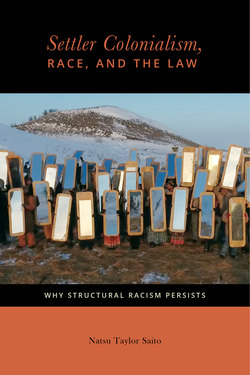Читать книгу Settler Colonialism, Race, and the Law - Natsu Taylor Saito - Страница 23
На сайте Литреса книга снята с продажи.
Many Worldviews
ОглавлениеEnvisioning more equitable and fulfilling ways of relating to one another, and of organizing our social, political, economic, and legal relations will require stories lived outside the constraints imposed by the dominant narrative. To survive within a colonial paradigm without being defined by it requires the development of multiple consciousness.87 As noted earlier, American settler society presumes a hierarchical social order that places humans second only to God (or some variant of Truth), and measures their superiority to other beings by the extent to which they dominate or control them. Not only human relations but property rights have been framed in accordance with this “natural order.” As Cherokee author Thomas King recounts in his playful retelling of the biblical scene in which Adam eats an apple in the garden of Eden: “Wait a minute, says that GOD. That’s my garden. That’s my stuff.”88 The perils of failing to comply with this system of domination and subordination are illustrated by Adam’s “fall from grace” and the eviction of humans from the garden of Eden.89 Those at the top own the “stuff,” decide who should have it, and are responsible for ensuring that everyone and everything remains in his/her/its place, literally and figuratively.
Many cultures see the world quite differently. To quote Seneca historian Barbara Alice Mann, “starting with a solitary, male and—most stunningly—portable god necessarily leads one onto a very different pathway from that which one treads by starting in the Old Way, in a cosmos of balanced Twinships made up of interactive Spirits of Place, in sky or earth, not to mention women as important cultural functionaries.”90 As Vine Deloria reported, within many American Indian religious traditions, “the whole of creation was good, and because the creation event did not include a ‘fall,’ the meaning of creation was that all parts of it functioned together to sustain it.”91 Humans can be understood not as destined to dominate or destroy nature, but as very literally related to all living beings. “Indigenous identity is formed by the intersection of land, culture, and community, and the way we respond to those critical elements of our existence defines the meaning of ‘sovereignty’ and ‘property’ for the First Nations of this land,” according to law professor Rebecca Tsosie. It is a reciprocal relationship, with the land looking after the people and “orient[ing] the people in understanding how to meet their responsibilities to each other and to the land.”92
According to Mann, “The entire Iroquoian world is made up of complementary pairs,” which “function[] synchronously so as to maintain a balanced cosmos.”93 The clans and the nations were consciously created and organized according to a twinship principle to ensure balance, and their equilibrium is maintained by a gendering that posits men and women as “natural halves that parallel one another, socially, politically, economically, and religiously.”94 Thus, while the only governing bodies acknowledged in settler accounts were composed of men, the Clan Mothers had their own councils that, among other responsibilities, “appointed warriors, declared war, negotiated peace, and mediated disputes.”95
This system of governance allowed the Haudenosaunee Confederation to prosper for many centuries prior to European contact, ensuring the well-being of the people through consultation with, and participation of, the individuals, families, clans, villages, and nations comprising the greater Iroquois League.96 Lumbee law professor Robert A. Williams Jr. notes that, in striking contrast to Western understandings of political authority, “above all, the Iroquois political system sought to assure that the Iroquois listened seriously to each other.”97 Councils met, often at length, until consensus was achieved, and the League Council’s decisions did not impose its decisions, but communicated them “‘to the people, hoping they would agree.’”98
These are just a few examples of the many worldviews, and ways of organizing society, that the American settler colonial state has done its best to destroy. Neither Indigenous perspectives and histories nor contemporary manifestations of Indigenous cultures can be incorporated into the master narrative in any meaningful way because they would undermine the legitimacy of the colonial project itself. More fundamentally, they cannot be acknowledged because there is no place in the European colonial zeitgeist for epistemological alternatives.
Expanding our narratives to incorporate the stories and realities of those deemed Other can free us to recognize that we live in a “pluriverse” of worldviews, as Gustavo Esteva and Madhu Suri Prakash frame it, and to recognize the constraints of our own.99 As we come to see that we need not limit our vision of future possibilities to the master narrative’s constructions of indigeneity, property, or civilization, its linear framing of progress, or the gendered and racialized social hierarchies it imagines, we may be able to break out of the highly circumscribed conceptual paradigm of individual rights and formal equality within which we have been operating, and come to understand racial justice in a richer way.
While remaining mindful of the pitfalls of substituting one universalizing narrative for another, we can begin to construct theoretical frameworks capable of explaining historical consistencies and disparities in structural rather than exceptional terms. In this process, I find it helpful to conceptualize racialization and racial hierarchy as a function of colonialism—settler colonialism in our case. To the extent that racism serves to consolidate colonial rule, its dismantling will require decolonization, and we will need narratives that accurately reflect this relationship in order to envision liberatory options. Because settler colonial theory is unfamiliar terrain for many of us, the following chapter briefly summarizes the constructs of colonialism that provide a conceptual framework for the remainder of the book.
